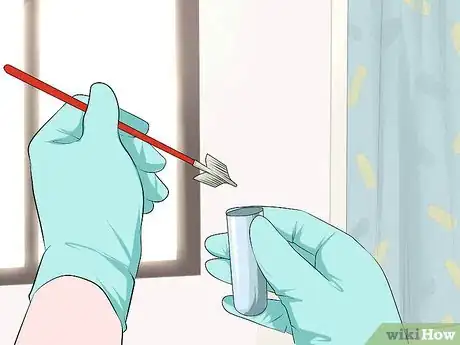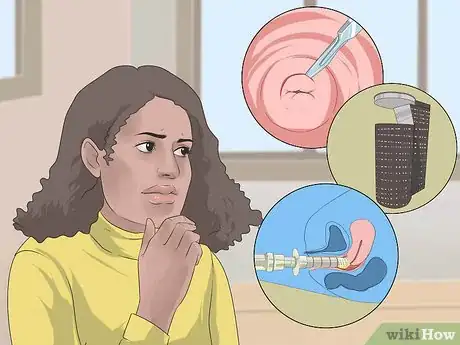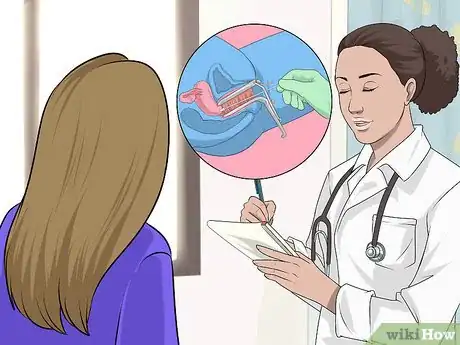This article was co-authored by Carrie Noriega, MD. Dr. Noriega is a Board Certified Obstetrician & Gynecologist and medical writer in Colorado. She specializes in women’s health, rheumatology, pulmonology, infectious disease, and gastroenterology. She received her MD from the Creighton School of Medicine in Omaha, Nebraska and completed her residency at the University of Missouri - Kansas City in 2005.
This article has been viewed 41,384 times.
Doctors regularly perform Pap smears (also called Pap tests) on female patients, typically during routine pelvic exams, in order to check for abnormal cell changes on the cervix. If untreated, these cell changes can sometimes lead to cervical cancer. “Negative” or “normal” results mean that no abnormal cervical cells are present and no follow-up is necessary until your next regularly scheduled exam. “Positive” or “abnormal” results, however, indicate a potential problem.
Steps
Understanding Your Results
-
1Stay calm. Many women become very anxious when they discover that the results of their Pap tests are “abnormal,” but at this stage, there is no reason to panic. In most cases, “abnormal” test results do not indicate cervical cancer. You’ll have to follow up with your doctor, and perhaps undergo further testing, in order to determine why the Pap smear showed suspicious cell changes on your cervix.
-
2Educate yourself about HPV. Most abnormal Pap smear results are caused by the Human papillomavirus (HPV). This is virus spread through sexual contact, and it is so prevalent that most sexually active people will contract it at some point.[1]
- There are many different kinds of HPV, some of which are known to have the potential to cause cervical cancer. Many people who have the virus, however, will never develop any symptoms and will clear it on their own. Having HPV does not mean you have or will ever get cervical cancer.
Advertisement -
3Consider the other possible causes of abnormal Pap smear results. It is possible to get false-positive Pap smear results, especially if you are taking birth control pills. [2] Some women also have cervical cell changes that are not caused by HPV. Hormonal imbalances, yeast infections, as well as having vaginal sex or using tampons, douches, or vaginal creams within 48 hours of your Pap smear, can cause abnormal results.
-
4Decipher your specific results. There are a number of different types of “positive” or “abnormal” Pap smear results, and some are more concerning than others. The next step will generally depend on the specific results of the Pap smear.[3]
- Atypical squamous cells of undetermined significance, or ASCUS, are cervical cells that appear slightly abnormal but are not necessarily cancerous or precancerous.
- Squamous intraepithelial lesion refers to cervical cells that may be precancerous. The results are graded from least to most severe using CIN 1, CIN 2, or CIN 3.
- Atypical glandular cells are glandular cells (the cells that produce mucus in your cervix and uterus) that appear slightly abnormal, but are not necessarily cancerous or precancerous.
- Squamous cell cancer indicates possible cancer already present in the cervix or vagina. This, along with adenocarcinoma, is one of the most potentially serious Pap smear results.
- Adenocarcinoma is possible cancer already present in glandular cells. This, along with squamous cell cancer, is one of the most potentially serious Pap test results. This may also be a sign of uterine cancer so you may also be tested for this using an endometrial biopsy.
Following Up With Your Doctor
-
1Make a follow-up appointment with your doctor. As soon as you get your results, your doctor will want to schedule a follow-up appointment. Do not postpone this appointment. Make the appointment for sometime within the next one to two weeks.
- Some women feel so anxious or upset about their test results that they avoid making follow-up appointments or skip their scheduled follow-up appointments. Abnormal Pap test results can be scary, but don’t give in to the urge to avoid thinking about them. Remember: you probably do not have cancer, and even if you do, starting treatment as early as possible will be crucial.
- If you had your Pap smear done by a general practitioner, you may be referred to a gynecologist for your follow-up appointment.
-
2Discuss your results with your doctor. When you go to your follow-up appointment, ask your doctor to clarify your results and explain them in detail. Ask what further testing he or she recommends and what comes next.
- Consider bringing a spouse, partner, or trusted friend to this appointment. When you are worried or upset, it can be difficult to listen carefully and remember everything your doctor tells you. Having someone else with you can serve two purposes: first, the emotional support will calm you down so that you can be a more attentive listener, and second, the other person can also listen carefully to the doctor and remind you later about details you may have missed.
-
3Get an HPV test. If you haven't already had this test, it may help your doctor better understand the cause of your abnormal Pap smear results and help him or her decide how to proceed with your treatment.
-
4Consider watching and waiting. For some abnormal test results, especially ASCUS and CIN 1, your doctor may suggest simply waiting and retesting in a few months.
- Abnormal cells often go away on their own, which is why you may need no treatment at all. If your abnormal Pap smear was caused by an HPV infection, your body may be able to clear the virus naturally.[4]
-
5Discuss hormonal causes. If your doctor suspects that your abnormal Pap smear results may have hormonal causes, he or she may write you a prescription to correct your hormone balance.[5]
-
6Ask about a colposcopy. Your doctor may also suggest a colposcopy: a procedure in which a doctor uses a magnifying device called a colposcope to examine your cervix more closely. If your doctor sees any potential problem areas, he or she can take a cervical biopsy for further testing.
- If you might be pregnant, mention it to your doctor before a colposcopy. The risk of miscarriage is small, but you may have bleeding after the procedure.
- Do not insert anything into your vagina (no sex, no tampons, and no douches or medicines) for at least 24 hours before a scheduled colposcopy.
Getting Treatment
-
1Find out if any treatment is necessary. In many cases, doctors will simply recommend that you continue getting regular Pap smears to keep an eye on your condition. However, you may also need to have some further testing done.
- Keep in mind that a pap test is only a screening test, so your doctor can’t tell you what is wrong from this test alone. The colposcopy and biopsies are diagnostic tests that you will need to have done to find out what is going on.
-
2Choose the right treatment for you. If your doctor recommends that precancerous cervical cells be removed, there are several treatment options available. These procedures may sound frightening and painful, but keep in mind that you will likely be given medication to numb your cervix and keep you comfortable.[6]
- Loop Electrosurgical Excision Procedure (LEEP) is a procedure in which your doctor cuts out abnormal tissue with a small electrified wire. This procedure is performed at your doctor's office using local anesthesia, and it only takes a few minutes. This is the most common treatment.
- Cryotherapy is another in-office procedure your doctor can perform by using a cold probe to freeze the abnormal cells. This procedure is very quick and may not require anesthesia.
- Cold knife conization is a procedure in which your doctor removes the abnormal cells using a scalpel. This procedure requires general anesthesia, so you will have to go to the hospital.
- Laser therapy is a procedure your doctor performs using a laser to remove the abnormal cells. Like cold knife conization, it is performed at a hospital using general anesthesia.
-
3Get a second opinion. If for any reason you believe that your doctor is not listening to your concerns or treating you effectively, or if you have any lingering questions about what your results mean, consider seeing another doctor. Don’t worry about offending the first doctor: medical professionals should understand and respect a patient’s wish to seek a second opinion.
-
4Find a specialist. If your doctor thinks you have cancer, he or she will refer you to a specialist. That person can help you navigate the best treatment options for your particular case.
-
5Continue to get regular Pap smears. Whether you had treatment following your first abnormal Pap smear or not, you should continue getting regular Pap smears as often as your doctor recommends. The frequency will likely decrease after you have had several normal tests in a row.
References
- ↑ http://www.cdc.gov/hpv/parents/whatishpv.html
- ↑ http://www.webmd.com/cancer/cervical-cancer/news/20030709/popular-pap-test-may-cause-false-results
- ↑ http://www.mayoclinic.org/tests-procedures/pap-smear/basics/results/prc-20013038
- ↑ http://www.cdc.gov/std/hpv/pap/default.htm#sec8
- ↑ http://www.cancer.gov/types/cervical/understanding-cervical-changes#6
- ↑ http://www.cancer.gov/types/cervical/understanding-cervical-changes#6























-Step-13.webp)


-Step-8-Version-3.webp)
















































Medical Disclaimer
The content of this article is not intended to be a substitute for professional medical advice, examination, diagnosis, or treatment. You should always contact your doctor or other qualified healthcare professional before starting, changing, or stopping any kind of health treatment.
Read More...